[/caption]Farewell Stardust-NExT !
Today marks the end to the final chapter in the illustrious saga of NASA’s Stardust-NExT spacecraft, a groundbreaking mission of cometary exploration.
Mission controllers at NASA’s Jet Propulsion Laboratory commanded the probe to fire the main engines for the very last time today at about 7 p.m. EDT (March 24). The burn will continue until the spacecraft entirely depletes the tiny amount of residual fuel remaining in the propellant tanks. The Stardust probe is now being decommissioned and is about 312 million kilometers away from Earth.
This action will effectively end the life of the storied comet hunter, which has flown past an asteroid (Annefrank), two comets (Wild 2 and Tempel 1) and also returned the first ever pristine samples of a comet to Earth for high powered analysis by the most advanced science instruments available to researchers.
NASA’s Stardust space probe completed her amazing science journey on Feb. 14, 2011 by streaking past Comet Tempel 1 at 10.9 km/sec, or 24,000 MPH and successfully sending back 72 high resolution images of the comets nucleus and other valuable science data. Tempel 1 became the first comet to be visited twice by spacecraft from Earth.
During the Feb. 14, 2011 flyby of Comet Tempel 1, Stardust-NExT discovered the man-made crater created back in 2005 by NASA’s Deep Impact mission and also imaged gas jets eminating from the comet. My imaging partner Marco Di Lorenzo and myself prepared two posters illustrating the finding of the jets and the Deep Impact crater included in this article.
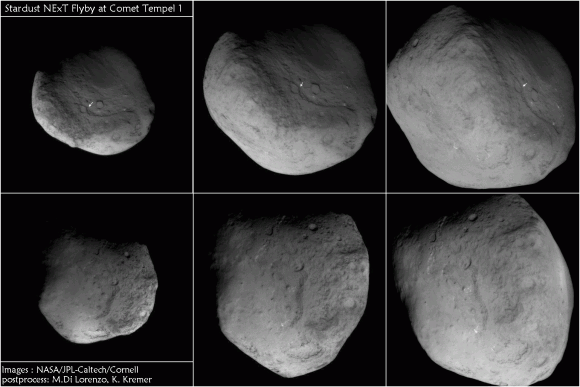
The images progress in time during closest approach to comet beginning at upper left and moving clockwise to lower left. Credit: NASA/JPL-Caltech/University of Maryland/Post process and annotations by Marco Di Lorenzo/Kenneth Kremer
The rocket burn will be the last of some 2 million rocket firings all told since the Stardust spacecraft was launched back in 1999. Over a dozen years, Stardust has executed 40 major flight path maneuvers and traveled nearly 6 billion kilometers.
The rocket firing also serves another purpose as a quite valuable final contribution to science. Since there is no fuel gauge on board or precise method for exactly determining the quantity of remaining fuel, the firing will tell the engineers how much fuel actually remains on board.
To date the team has relied on several analytical methods to estimate the residual fuel. Comparing the results of the actual firing experiment to the calculations derived from estimates will aid future missions in determining a more accurate estimation of fuel consumption and reserves.
“We call it a ‘burn to depletion,’ and that is pretty much what we’re doing – firing our rockets until there is nothing left in the tank,” said Stardust-NExT project manager Tim Larson of NASA’s Jet Propulsion Laboratory in Pasadena, Calif in a statement. “It’s a unique way for an interplanetary spacecraft to go out. Essentially, Stardust will be providing us useful information to the very end.”
Just prior to the burn, Stardust will turn its medium gain antenna towards Earth and transmit the final telemetry in real time. Stardust is being commanded to fire the thrusters for 45 minutes but the team expects that there is only enough fuel to actually fire for up to perhaps around ten minutes.
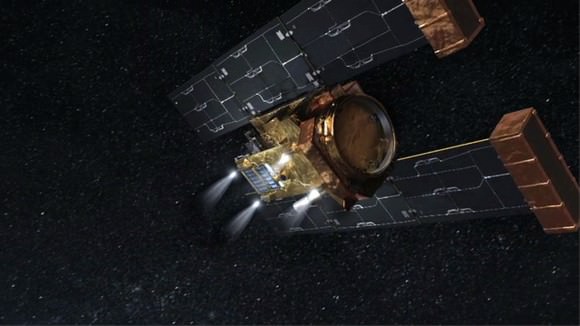
As its final act, the transmitters will be turned off (to prevent accidental transmissions to other spacecraft), all communications will cease and that will be the end of Stardust’s life.
With no more fuel available, the probe cannot maintain attitude control, power its solar array or point its antenna. And its far enough away from any targets that there are no issues related to planetary protection requirements.
“I think this is a fitting end for Stardust. It’s going down swinging,” Larson stated in the press release.
Read more about the Stardust-NExT Flyby and mission in my earlier stories here, here, here, here, here, here and here
Relive the Feb. 14 Flyby of Comet Tempel 1 in this movie of NASA/JPL images
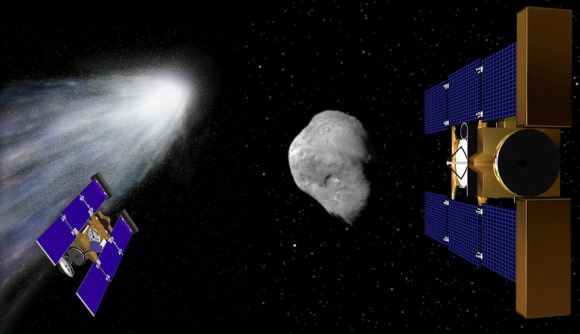
Stardust-NExT made history on Valentine’s Day - February, 14, 2011 – Tempel 1 is the first comet to be visited twice by spacrecraft from Earth. Stardust has now successfully visited 2 comets and gathered science data: Comet Wild 2 in 2004 (left) and Comet Tempel 1 in 2011 (right).
Artist renderings Credit: NASA. Collage: Ken Kremer.
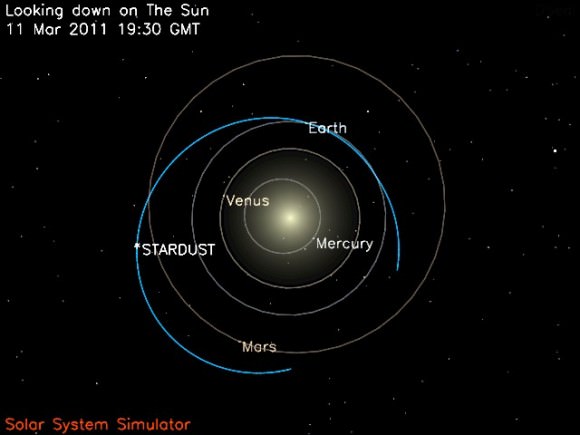

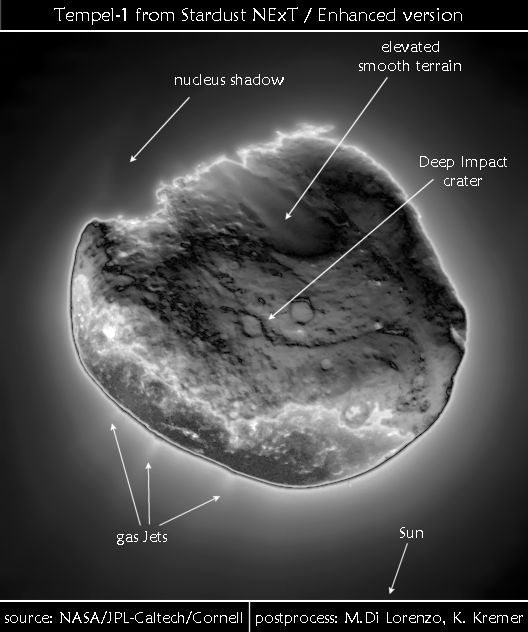
Maybe I missed something, but where does it go now? Is it in an orbit, heading into the sun, headed out of the solar system? It doesn’t just disappear when it is turned off, so where is it headed?
As you can see form the graphic above, it’s in a nearly mars sized rather elliptical orbit around the sun.
The graphic doesn’t show a complete orbit, and even if it was in orbit, the terminal burn would change the orbit or take the craft out of orbit. I know it poses no current danger to anyone, but it would behoove us to know where it will be for future reference.
A complete unpowered orbit will be an ellipse in a gravitation field (see Kepler’s laws). The burn will not change it perceptibly AFAIK.
In 2173 an asteroid prospector craft headed back home will spot it, snag it and sell it to the NASA museum for 4.6 billion dollars which will enable the prospector to buy a quantum flux upgrade to her VASIMR drive.
Yes, that, or some Bird of Prey will use it as target practice.
One of my most memorable telescopic observations was seeing Tempel 1 brighten dramatically as the Deep Impact mission unfolded. The comet itself was barely visible in my C14, but suddenly there was a bright spot that just kept growing.
Thank you Stardust-NExT, for showing us the result of that impact! And well-done to all those involved in the Deep Impact and Stardust-NExT missions!
Bye, bye, Stardust! You had a great mission & a great life now all that has come to an end with this final goodbye!